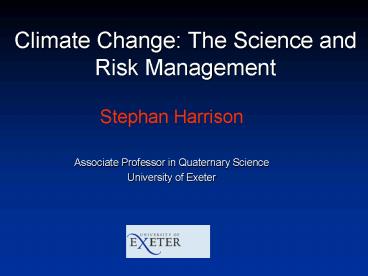Climate Change: The Science and Risk Management - PowerPoint PPT Presentation
1 / 17
Title:
Climate Change: The Science and Risk Management
Description:
To assess the risk management implications of climate change ... Stratigraphy Commission of the Geological Society of London. The Geological Society of America ... – PowerPoint PPT presentation
Number of Views:48
Avg rating:3.0/5.0
Title: Climate Change: The Science and Risk Management
1
Climate Change The Science and Risk Management
- Stephan Harrison
- Associate Professor in Quaternary Science
- University of Exeter
2
To assess the risk management implications of
climate change we must
- Understand contemporary climate change
- Assess climate sensitivity
- Understand past climate change
- Recognise uncertainty and rapid change
3
Set the scene IPCC, GHG, past and future climate
- Intergovernmental Panel on Climate Change set up
by WMO and UNEP in 1988 - Four reports (1991, 1995, 2001 and 2007)
- The most comprehensive review and evaluation of
any science in human history
4
Its conclusions are supported by
- 2007 The national science academies of the G85
nations - 2005 The national science academies of the G8
plus India China and Brazil - 2001 the national science academies of 16
leading industrial nations - 2001 US National Research Council
- 2003 American Meteorological Society
- 2003 American Geophysical Union
- 2003 American Institute of Physics
- 2004 American Astronomical Society
- American Association for the Advancement of
Science - Stratigraphy Commission of the Geological Society
of London - The Geological Society of America
- The American Chemical Society
5
IPCC AR4Detection Temperature Rise
6
Global mean temperatures are rising faster with
time
Period Rate Years ?/decade
7
Human and Natural Drivers of Climate Change
- CO2, CH4 and N2O Concentrations
- - far exceed pre-industrial values
- - increased markedly since 1750
- due to human activities
Relatively little variation before the industrial
era
IPCC AR4
8
Global-average radiative forcing estimates and
ranges
9
Equilibrium Climate Sensitivity
Surface warming following a sustained doubling of
CO2 concentrations
Best estimate 3C likely 2-4.5C very
unlikely less than 1.5C higher values not
ruled out
IPCC AR4
10
The Future atmospheric concentrations and
temperature
11
How do we predict the future? General Circulation
Models
- Used to unravel cause and effect in the climate
and earth system - Models are the only means to predict future
climates - Models are our experimental laboratory
- AGCMs OGCMs AOGCMs ESMs
12
Projections of Future Changes in Climate
Best estimate for low scenario (B1) is 1.8C
(likely range is 1.1C to 2.9C), and for high
scenario (A1FI) is 4.0C (likely range is 2.4C
to 6.4C).
IPCC AR4
13
Problems with models future climate change
- Climate system much more sensitive, non-linear
and dynamic than previously believed - May display emergent behaviour
- Models dont recreate this behaviour
14
The main risk?IPCC AR4 Sea Level Projections
- Ice sheet models are inadequate
- Equilibrium sea level response to 3 C warming
is 25m?
15
The Changing Risk Environment (1)
- Physical Flooding, drought, landslides,
increased storminess - Political Who will people blame when their homes
flood or become worthless? Litigation and
reputational risks - Due diligence and public indemnity issues (will
insurers be expected to assess climate change
risks?) - Implications for Business Interruption?
- Social Migration, civil unrest
- Rapid changes in consumer behaviour effects on
supply networks costs of raw materials,
transport and energy - Problems base future projections on recent past
data sets created when forcings were different
16
The Changing Risk Environment (2)
- Policy on planning for climate change based on
Magnitude / Frequency relationships which may be
uncertain
- 2003 heatwave caused 22-35,000
excess mortality - 1500 year event
R. Stöckli, ETHZ
17
Conclusions
- Climate change more rapid than previously thought
- Past data sets may not prepare us for future
change - The risk environment has changed makes business
planning difficult - Models do not always show climate variability nor
do they show statistical skill at regional level - Future risk assessments must take into account
the cultural and social responses to climate
change































